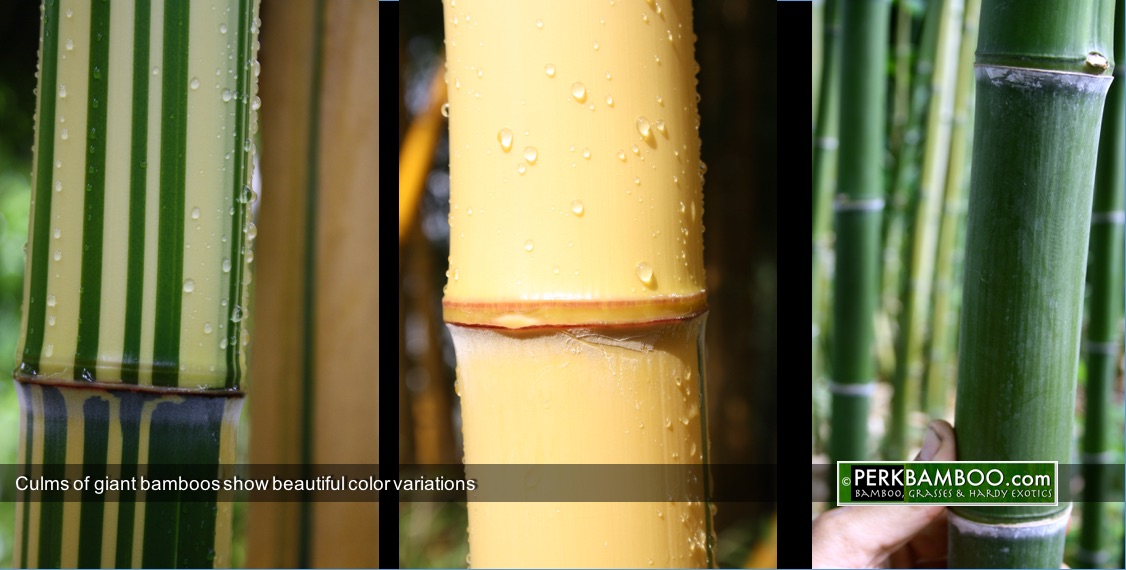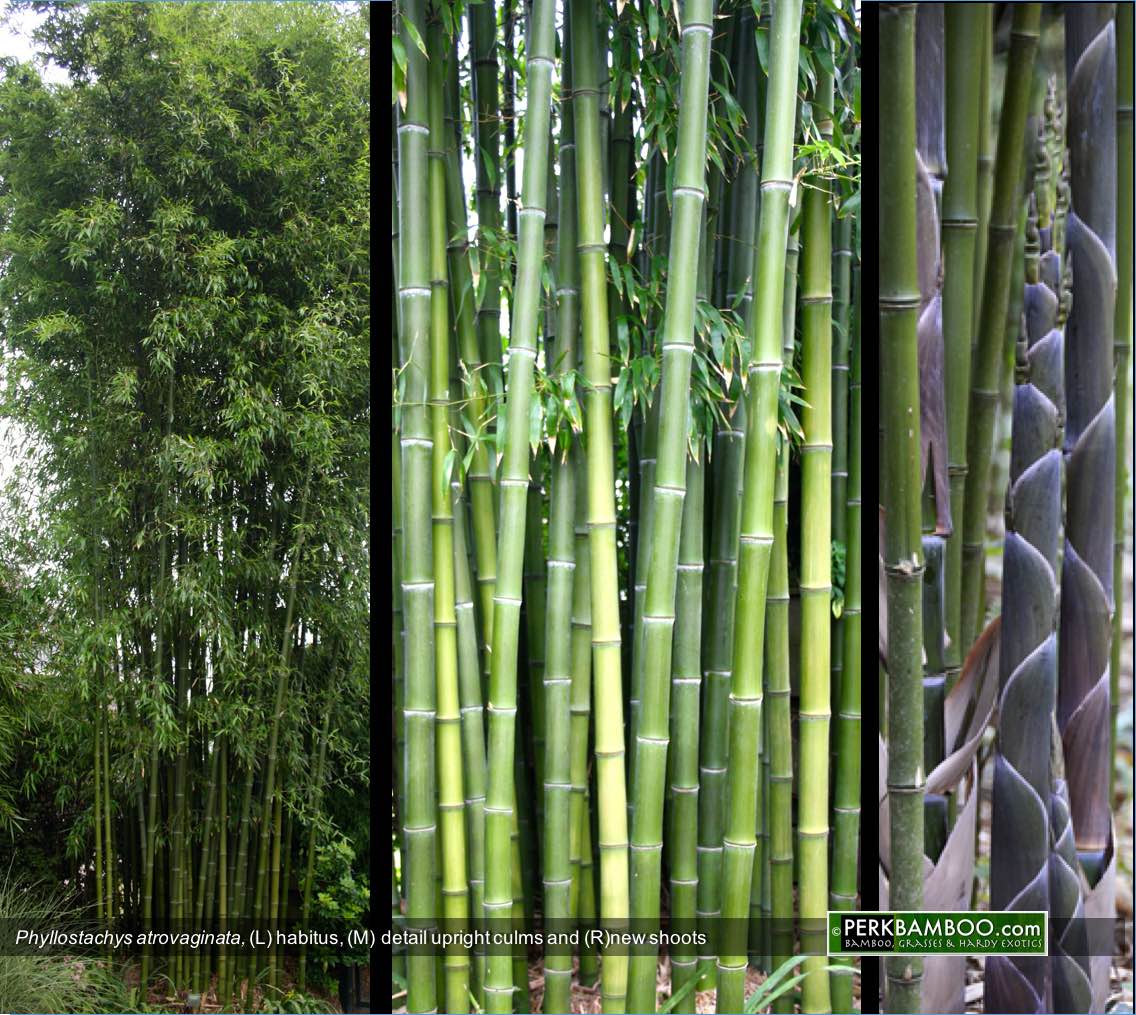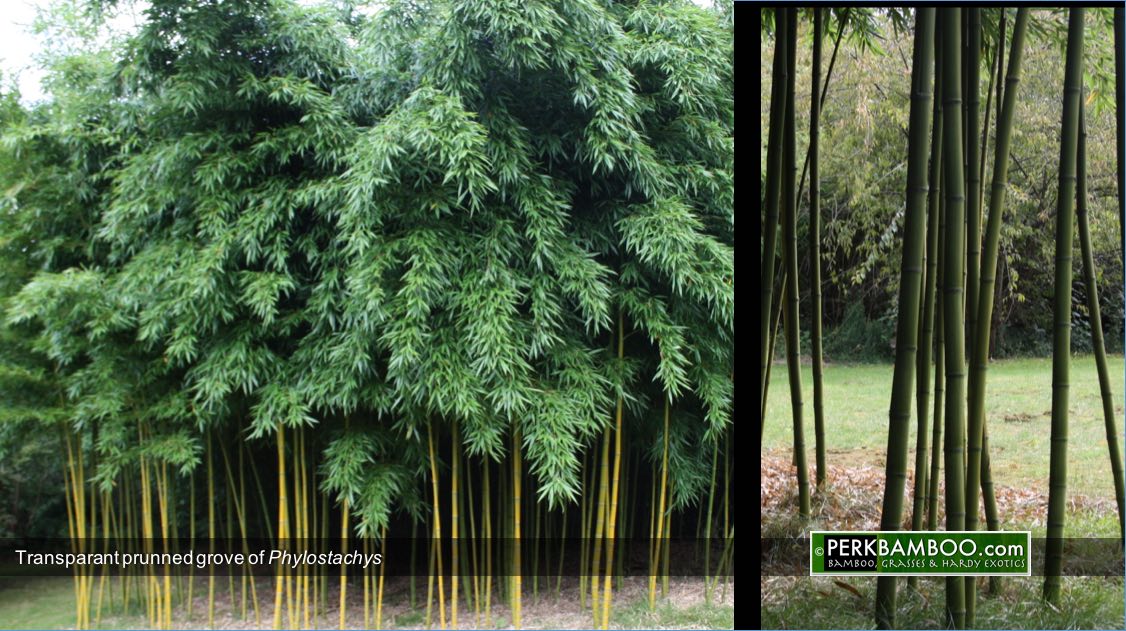BAMBOO GROVE

An open bamboo grove where sunlight plays through the stylistic culms has its own mystic atmosphere. A bamboo grove can be achieved from small to large scale. A bamboo grove provides edible shoots, bamboo wood and fibers for technical and visual applications. A pruned bamboo grove is also a beautiful element in a garden. Think also of bamboo recreational groves in city parks, as part of natural playgrounds, or bamboo production agro-forestry for bio-based raw materials on farmland.

TRANSPARANT BAMBOO GROVE
Without pruning most bamboos grow into a very dense grove. By selectively reducing the number of stems per square meter and cut off the side branches of the remaining stalks to about 1/3 of the total height one is able to create a transparent grove where the attention goes to the stylistic structure of the culms. This also creates more visual space in the garden and enough light on the ground for a varied understory. This pruning technique can be applied to many kinds of bamboos. Especially the medium to giant species of the genus Phyllostachys with beautiful culm colors and patterns give a great result. Fargesia’s with their dense and compact growth are less suitable, except for Fargesia sp. Scabrida and some Borinda's. Spotlights can highlight the stylistic culms at night.
BAMBOO PRODUCTION AS AGRO-FORESTRY SYSTEM
For the production of bamboo culms for bio-based raw materials, the strongest, highly productive species are selected to establish bamboo plantations with. Species with high culm density, an upright, straight growth and high biomass production can be found among Phyllostachys, Semiarundinaria and Bashania. We are actively engaged in consulting, plant production and implementation of projects in this field. Please contact for more information.
SPECIES SELECTION
Many bamboo species can be cultivated as bamboo grove. A selection of suitable species is listed below. More species are possible (and available), depending on your local climate and situation. Please contact for specific advice and more information.
MEDIUM-HIGH BAMBOOS
Within the medium sized bamboos of 4-7 meters there is a lot of color and shape variation available. By selective thinning and pruning the following types are very worthwhile to apply as a grove:
Phyllostachys aureosulcata is a very useful species group for this application. This sturdy upright growing species shows a lot of color diversity within its cultivars, is very hardy and versatile. Typical for aureosulcata is the zigzag growth of a part of the culms in first meter of the culm. The most important cultivars are:
Phyllostachys aureosulcata has green culms with a vertical yellow stripe alongside every internode. Phyllostachys aureosulcata 'Aureocaulis' has deeper yellow-ocher culms. The new stems are lemon yellow and discolored on the sunny side to wine red.
Phyllostachys aureosulcata 'Spectabilis' is the inverted form of aureosulcata and has a yellow culm length with a green vertical stripe around-and-around the culm.

Phyllostachys bissetii is a very hardy green botanical Chinese bamboo with a high biomass production. Many other green, botanical species exist with all their own characteristics. Just to name a few: Phyllostachys humilis is a relatively smaller species, Phyllostachys nuda is more popular for its hardiness and growth power in the USA, somehow lesser known in Europe, Phyllostachys incarnata has remarkable purple-redbrown new shoots and thick white powdered culms, Phyllostachys elegans is a very beautiful bamboo regarding habitus and culm coloring, Phyllostachys viridiglaucescens and especially Phyllostachys glauca have blue-powdered stalks.


In sheltered spots against a light background is a single grove of Phyllostachys nigra, with its distinctive shiny black culms very worthwhile. The frost resistance of Phyllostachys nigra is however limited. The green form Phyllostachys nigra 'Henonis' is stronger en grows bigger in northern Europe.

GIANT BAMBOOS
Even for northern European cool temperate climates, bamboo species exist that can grow to huge sizes. By "giant bamboo" we mean species with a growth height of 7 - 10+ meters and culm diameter 5+ cm. To achieve these dimensions, the plants need a large plot with plenty of sunshine and nutritious, moist, humus-rich soil. In small numbers, the following types are available which you can also find in the show garden:
Phyllostachys atrovaginata together with Phyllostachys parvifolia showed to be one of the strongest and most hardy giant bamboo. It's not an explosively fast growing species, so the plant needs more time to grow mature than for example a Phyllostachys vivax. It is also a bamboo with some special properties: due to the air ducts in the rhizomes this species is able to survive in a wet soil and may even temporarily get flooded. A second feature is the typical smell of sandalwood released by rubbing firmly over the older culms. It's a sturdy upright species with strong culms. The gray-green shoots appear annually in June-July. There is also a plant in circulation with the name 'Green Perfume', this is a plant from laboratory tissue culture (in vitro) which we deliberately don’t grow. Our plants are manually propagated from the original mother plant so that the species characteristics are guaranteed. Limited stock.

Phyllostachys parvifolia. This Chinese giant bamboo grows naturally in Zhejiang Province. This bamboo has striking sturdy stalks in combination with relatively fine leaves, somewhat similar to Phyllostachys nigra 'Henonis'. Based on experience in Northern Europe during a series of rigorous winters over the past decades it can be concluded that Phyllostachys parvifolia is one of the strongest giant bamboos. In cooler summer climates this species needs more time to grow into adult proportions than for example a Phyllostachys vivax. In our garden after about 10 years the first thicker culms appear of more than 8 cm in diameter. The new culms have a particular ornamental value by striking white powder node ring in contrast to the initial gray-green culms. Later the stems color from olive green to dull green. The typical gray-pink colored new shoots appear until mid-June, sometimes July. In our garden parvifolia biannually produces shoots. It is a more difficult-to-propagate bamboo so the availability is limited.

Phyllostachys sp. ‘Shanghai 3’ one of the largest bamboos for our climate. "Shanghai 3 ‘ botanically belongs to Phyllostachys dulcis complex. Under optimal conditions, this species reaches a height of 8-12 meters with a trunk thickness of 5-7 cm. For this tour de force is necessary: time (about 10 years), regular manure, irrigation in summer and a convenient stand with lots of sun.
In our garden we also have a giant bamboo with strikingly hardiness and strong growth power that has withstood the extreme cold of February 2012 (-23). This is probably another clone, also being distributed as Shanghai-3 by Hans Prins and Jos van der Palen imported rhizomes similar name but appears to be an other clone. This plant has culms with a diameter of 90 - 100 mm. The stems are very strong, upright and wind resistant. To differentiate we named this plant Phyllostachys ‘Shanghai 4'. "Shanghai-4" makes its new shoots 2 to 3 weeks earlier than 'Shanghai-3'. Only available on pre-order.

Phyllostachys vivax 'Aureocaulis' has yellow ocher culms with sometimes narrow green longitudinal stripes. This cultivar is also known as the King of bamboos. It is one of the most impressive giant bamboos for our climate. After the culm sheets fall, the stems immediately look freshly colored, with sometimes alternating bright green stripes as if an artist used a pencil. Sometimes a culm mutates in part to the form ‘Huanwenzhu’. The final height of this species is 7-10 meters and demands the same requirements as the green form Phyllostachys vivax Mc Clure or Jantonqing. Young plants tend to grow overhanging. The thinner culm wall makes more susceptible to breaking from heavy snow loads and rainstorms.

Phyllostachys vivax 'Huanwenzhu' has a beautiful deep green culm and a bright yellow sulcus. This provides together with the very thick culms (eventually 5-8 cm), an impressive result. A very beautiful solitary for a large space. Even after severe frosts, the leaves and culms show only little damage.

Phyllostachys vivax 'Huanwenzhu-Inversa' is a stable inverse color form selected in 2005 by Hans Prins and Jos van der Palen. The culms of this clone are bright yellow in color with a broad green sulcus, supplemented with variable light green vertical longitudinal stripes around the stalk. The result is a very beautiful, graceful culm with a tropical look. A similar hue we find with the smaller new species Phyllostachys aureosulcata 'Argus'.



